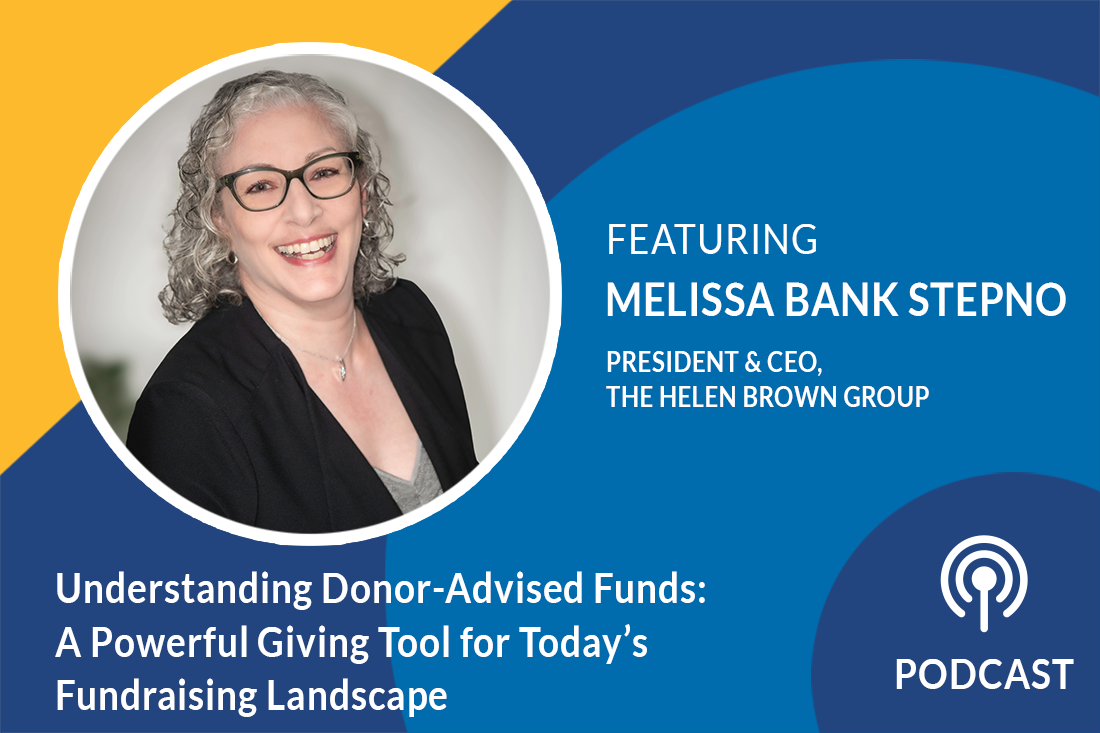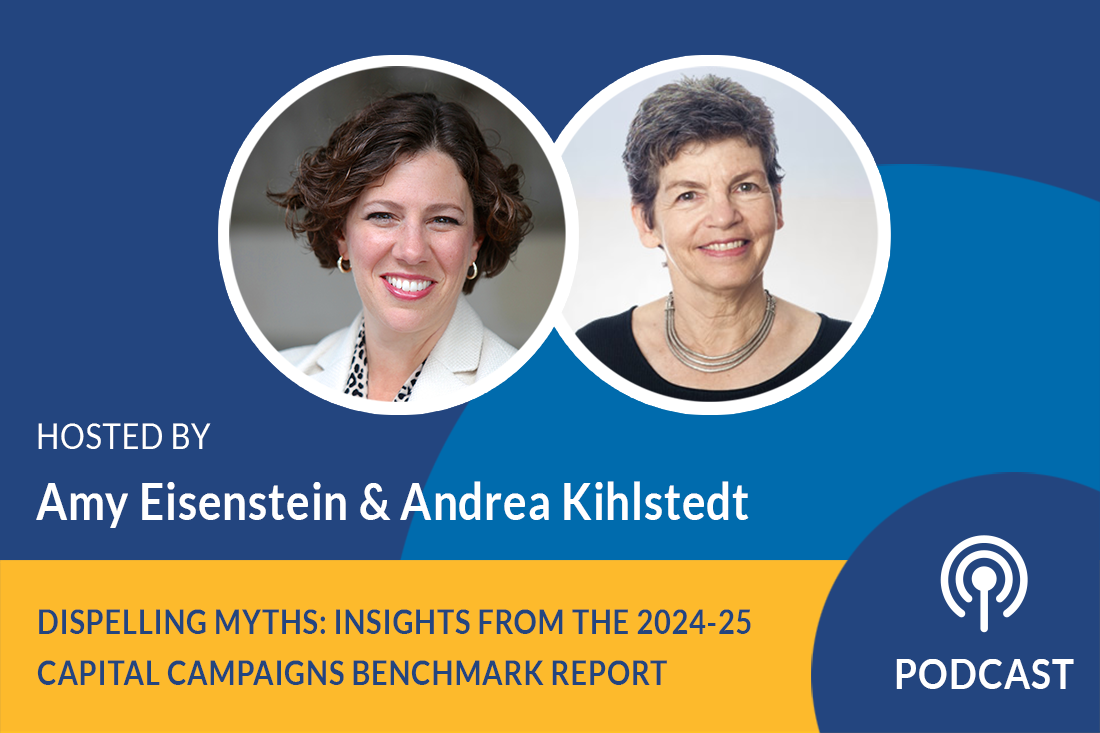Podcast: Why Donor Stewardship Matters and Why You Need a Plan

Season 2, Episode 62
Have you ever wondered how to determine the right price for a naming opportunity in your new building? In this episode, campaign experts Amy Eisenstein and Andrea Kihlstedt talk about donor stewardship and why it’s important during a campaign.
Listen Now:
Amy Eisenstein:
Have you ever wondered how to determine the right price for a naming opportunity in your new building? Well, if you have, stick around. We’re going to give you the answer right now.
Hi, I’m Amy Eisenstein. I’m here with my colleague and co-founder, Andrea Kihlstedt. And today, we’re going to talk about donor stewardship and why it’s important during a campaign. Andrea, why don’t you kick us off?
How to Determine the Right Gift for a Naming Opportunity
Andrea Kihlstedt:
Thanks, Amy. Yeah, this is a great topic. I mean, honestly, I think that some of the most fun parts of capital campaigns are figuring out how to thank donors and how to steward them and how to make them feel appreciated. That’s the fun part of fundraising. With a capital campaign where people have often given so generously over and above what they usually give, there’s particular sweetness in being able to do that. Let us first talk about how to figure out how much a room costs.
Amy Eisenstein:
Yes.
Andrea Kihlstedt:
Of course, that’s really the wrong question, isn’t it?
Amy Eisenstein:
It is the wrong question. Actually, let me tell you a funny story before you tell us how to figure that out. I was talking to a prospective client the other day, and they told me that they had asked the builder how much the materials to build a room cost and had asked the donor for that amount. I wanted to bang my head against the desk because the poor thing had asked the donor for $10,000 for this room because that’s how much the building materials cost.
In fact, the room price for sponsorship for naming opportunities should have been $100,000, 10 times what it actually costs. No, it doesn’t actually have to do with how much it costs to build the room. Why don’t you talk about how to figure it out?
Andrea Kihlstedt:
The other misconception, I’ll give you one more misconception that happens, which is the sense that when a donor gives a gift and to name a room, that the donor thinks they have bought the room.
Amy Eisenstein:
Yes.
Andrea Kihlstedt:
I mean, that’s a problem. In a campaign I did years ago, a donor gave a generous gift to fund a chapel in a hospital, a non-denominational chapel in a hospital. It was a wonderful and a generous gift. The challenge came later when she thought that she could make all the decisions about decorating it.
Amy Eisenstein:
Yes.
Andrea Kihlstedt:
Selecting the furniture, selecting the art for the walls, and she was sure it was her chapel. It wasn’t the hospital’s chapel. Miscommunication because, of course, naming opportunities are not buying spaces. They are not paying for spaces. Naming opportunities are donor recognition opportunities. They’re opportunities to recognize people’s generosity by connecting their names with particular spaces in the building if you have a building campaign.
Naming Opportunities Based on Visibility
Now, my friend Robert Pierpoint, from whom I learned a huge amount, used to say that naming opportunities are based on what he called checks appeal, by which he meant that spaces that had the biggest visibility, the best visibility, went to the donors whose checks were the biggest, who gave the largest gifts to the campaign. If there’s a lobby or an entryway that everybody goes by as they walk into the building, even if it’s a fairly small space, that entryway will have an outsized price tag on it. It will take a big gift to name that because it will be very visible.
Amy Eisenstein:
Right. I think that’s a perfect example.
Andrea Kihlstedt:
Proportionately smaller. Now, as we talk about proportional giving, what do we think about? We think about the primary capital campaign tool, which is the gift range chart. Now, Amy, you want to tell people what a gift range chart is just in case they don’t know, and I hope they do?
Consider Your Gift Range Chart
Amy Eisenstein:
I think it’s important for us when we use jargon to explain it. The gift range chart goes by many names. People call it the gift table or the gift pyramid, but basically it is a chart that outlines the number of gifts and the gift sizes that you need in order to accomplish your campaign.
For example, I’m going to use small round numbers, if you are raising a million dollars, that’s your goal, you might need one gift of 200 or $250,000. You might need three gifts of $100,000 and four or five gifts of 500 and on down. A few large gifts at the very top and slightly more gifts as you go down in amount, and then a lot of gifts at the bottom for your base.
Andrea Kihlstedt:
And that chart becomes a roadmap for your entire campaign. I think many people in the fundraising world know what those charts are, but they don’t understand how important they are. They don’t understand that they can guide everything, including donor recognition, to get the topic.
You can design (and you should design) your donor recognition program based on the levels of giving for your gift range chart. You should think about recognizing people in different ways at the top of the chart, in the middle of the chart, and at the bottom of the chart.
Because you can’t recognize the 400 people who will give you small gifts in the same way that you can recognize the 20 people who will give you large gifts. If you’re going to develop a donor recognition program, pull out your gift range chart and think about it, think about organizing it according to the levels of giving that are laid out in your gift range chart.
Now, you should also develop your naming opportunities list, that is pulling out the names of the spaces in your building, how big a gift you’re going to need for each of those spaces based on the gift range chart.
For example, to use Amy’s example, if there is one gift of a quarter of a million dollars at the top of that million dollar campaign, you need at least one naming opportunity for a quarter of a million dollars. If there are two gifts at $100,000, you need at least two naming opportunities for $100,000. If there are four gifts of $50,000, you need at least four naming opportunities for $50,000 and going down.
The typical pattern is to pull out the architectural plan of your building and make a list of all of the places that you think could be naming opportunities, starting with the flag pole and the lobby and the reception desk and the elevator banks and the exam rooms or the classrooms or the garden. I mean, list as many things as you possibly can, and then put them in the order of checks appeal.
Amy Eisenstein:
Right. Checks appeal. Visibility.
Andrea Kihlstedt:
Are the visibility, which ones have the most visibility. And then make sure that you have at least one naming opportunity correlating to each of the gifts on your gift range chart down to the level below which you will not give a naming opportunity to a specific space. You’ll see. If, I don’t know, you need 15 gifts of $10,000, you may not have 15 naming opportunities that are appropriate at that level. You’re no longer going to be putting individual plaques in individual rooms at those levels.
That’s the way to figure out how to put a gift dollar amount on a particular room in the building to recognize your donors, not by talking to the contractor.
Amy Eisenstein:
Or making it up.
Give Your Board a Chance to Weigh In
Andrea Kihlstedt:
Or making it up. Once you have that list of naming opportunities, you do want your board to look at it and approve it, because you don’t want to be negotiating with donors. If a donor says, “Well, I’d like to name the auditorium, but I don’t want to name it for a quarter of a million dollars. I’ll give you $100,000,” you need to be able to say, “You know what? This list has been approved by our board. I can’t go and make changes to it now because it unravels the entire sense of these naming opportunities. Our board has taken a close look at this.” You protect yourself that way.
Amy Eisenstein:
I love that. I mean, there is a method to the madness. It is not random and arbitrary. You are following your gift range chart, which is essentially the backbone of your campaign plan. These gift naming opportunities have a direct correlation to the gift range chart. People will say, “Well, if we want to let somebody name the building, how much is that? Well, what’s your top gift?” And that’s what you get to name the building. That’s often what you get to name the building for, and it should be at least about 25% of your campaign goal to name the building.
DEI With Respect to Naming Opportunities
Now, I do want to acknowledge that there is a lot of important discussion happening these days around the issue of DEI and donor recognition.
Many organizations are opting not to go with these traditional naming practices, which is fine and good if that’s appropriate in your community for your organization. I think that there are emerging lots of different ways to think about donor stewardship and recognizing donors at all levels of the campaign. But we do want to acknowledge and explain what some of the traditional ways are and give you the opportunity to think outside the box of how you are going to proceed once you have all the options in front of you.
Andrea Kihlstedt:
It’s so important, Amy. While there are some organizations that really are reconsidering whether they will do naming opportunities, and I hope more of them do reconsider, honestly, it is just a few so far. I find that there is a worry that donors will be upset, that donors want naming opportunities.
Honestly, in my view, many fewer donors give because of naming opportunities. That’s not why they give. It’s a donor recognition plan, but many donors are perfectly happy to have you recognize them in other ways. You don’t need to offer naming opportunities for many organizations. Some donors care.
But unless you’re talking about an organization with really high visibility, maybe their corporate donors, of course, corporate donors are looking for more visibility. They may be giving out of their marketing or advertising budgets. That’s a different story. But many individuals are happy to give quietly and to be recognized in ways that are more personal and less visible. It’s uncomfortable for some donors to be recognized visibly. I think we need to look carefully at these days. I’d like to see more people look at different ways to do that.
The Greater Role of Stewardship
Amy Eisenstein:
So far in our conversation, we have focused on room naming opportunities, but stewardship is so much more than that. To me, it’s about everything that happens after a donor makes a gift. How are we ensuring that that donor knows how their money was used? I mean, it’s more than donor recognition. It’s more than a plaque on the wall. One of these wonderful little organizations, it’s a soup kitchen and hunger organization, and they have a culinary school where they are teaching people to be sous chefs in order to help with employment opportunities. They have a baking unit and they send their donors wonderful cookies.
To me, it’s showing how the money’s used, that people are doing wonderful work, acknowledging that they’re part of the process and that they’re an important part of the organization. To me, there’s many, many opportunities to both recognize your donors, acknowledge them, let them know how their gift was used and the impact that they’re having. These people are going to be employed in more meaningful ways because donors support this organization. It’s not just about giving them a meal, although that’s a critically important component of the project. It’s also about providing employment skills.
These cookies are better than any cookies you’ll find anywhere. It’s a wonderful thing, if you can connect your stewardship to your programs and services. I mean, I never forget a children’s choir. They recorded a concert and you could have a concert at home. How wonderful was that? If you didn’t make it to the concert, you could still enjoy the music from the comfort of your own home. There’s many ways to share the impact, the benefits that you as donors are making.
Andrea Kihlstedt:
I think we often forget the simplest ways to recognize people, Amy. Sometimes I think they’re the most powerful. For example, when an organization gets a grant, a new gift of some sort, a big gift. One of the organizations I work with got a big gift today. I just heard about it today. The executive director is going to take the time to send about a half a dozen personal emails to people who have already made significant gifts to this organization to let them know, to let them be the first to know.
Amy Eisenstein:
Yes.
Being Treated as an Insider
Andrea Kihlstedt:
There is something about being treated as an insider that is wonderful donor recognition, that they are no longer just out there, but that the executive director actually is thinking about them. It’s not a mass email. He’s going to individualize very quickly, just a whole bunch of little bitty emails to people who have already been so generous to say:
“I thought you’d like to know that we’re up to this amount of money. Today we heard about a new gift of such and such. You have been so wonderful in helping us get to this place so far.”
That’s powerful.
Amy Eisenstein:
That is powerful. I love that.
Andrea Kihlstedt:
So simple.
Be Thoughtful About Your Stewardship
Amy Eisenstein:
Well, and I just want to share that this is not something that you do on the fly. This is something that is carefully and thoughtfully planned out in advance of your campaign. You don’t want to be scrambling after you get gifts to figure out how you’re recognizing donors. Members of Capital Campaign Pro do have templates and samples and guidelines on how to think about creating their stewardship plans, their stewardship activities, so that they are well prepared as they enter into the campaign, not as they’re finishing and wrapping up their campaign thinking, “Oh my gosh, how are we going to thank our donors? Or what are we going to do to share the impact?”
But the plans are created in advance, developed using the templates that are inside the Capital Campaign Pro toolkit so that they have that plan and that recognition all laid out in advance.
Andrea Kihlstedt:
I mean, to go back to the example that I just gave, my client, they have kept from the beginning a list of people and emails of people who give over a certain amount. The list is accessible and easy to pull up, and it becomes very easy for him to have a list of those emails that he can individualize little emails too.
Now, that was determined in advance, not after the fact. He is not having to scramble to say, “Well, who should I send these things to?” They actually were thoughtful about having a system or a process by which they keep track of the people who are giving it the higher levels, specifically for these little touches from the campaign chair or the executive director.
Amy Eisenstein:
Excellent. I want to remind listeners, if you are thinking about a capital campaign or planning a capital campaign or just getting started on your capital campaign and you do want some support or guidance or advice around this, we do offer free strategy sessions to discuss your campaign and answer any questions you have.
I want to encourage you to head on over to Capital Campaign Pro website and visit us and sign up for a free strategy session to discuss the specifics of your campaign. Excellent. I think this was a great conversation on stewardship. It’s really important to think about this as you’re planning your campaign.
Final Thoughts
Andrea Kihlstedt:
Don’t just go into a campaign and figure, “We’re going to steward people later.” Go into a campaign, and as you’re planning the campaign, plan your donor range and stewardship right in advance. That doesn’t mean you can’t change it as you go, but go in with an intention that this is what you’re going to do and this is how you’re going to do it. And that’s going to keep stewardship right in the forefront of your mind from the very beginning when you’re first soliciting those largest gifts all the way through to the end.
That’s going to make everyone involved in your campaign feel happy that they were a part of what you’ve done, and that’s going to make them want to be part of your next campaign as well. And that’s super important.
Amy Eisenstein:
Excellent. Thanks so much, Andrea. Thanks for listening, and we’ll see you next week.



Educative.